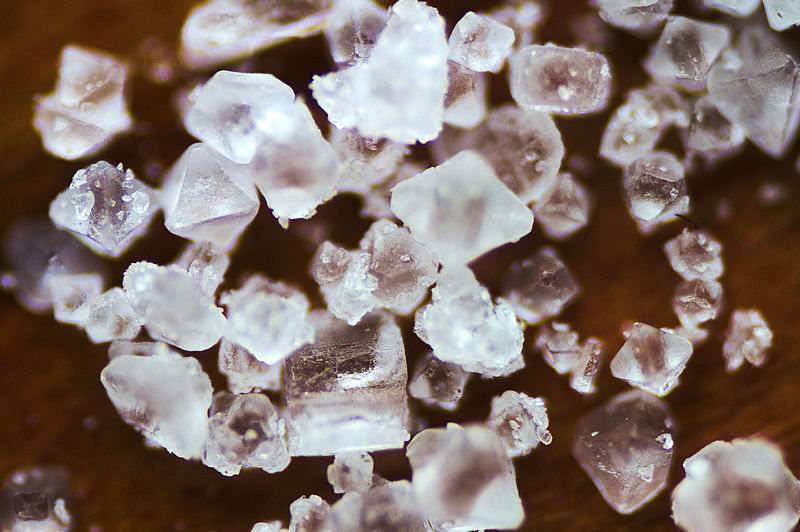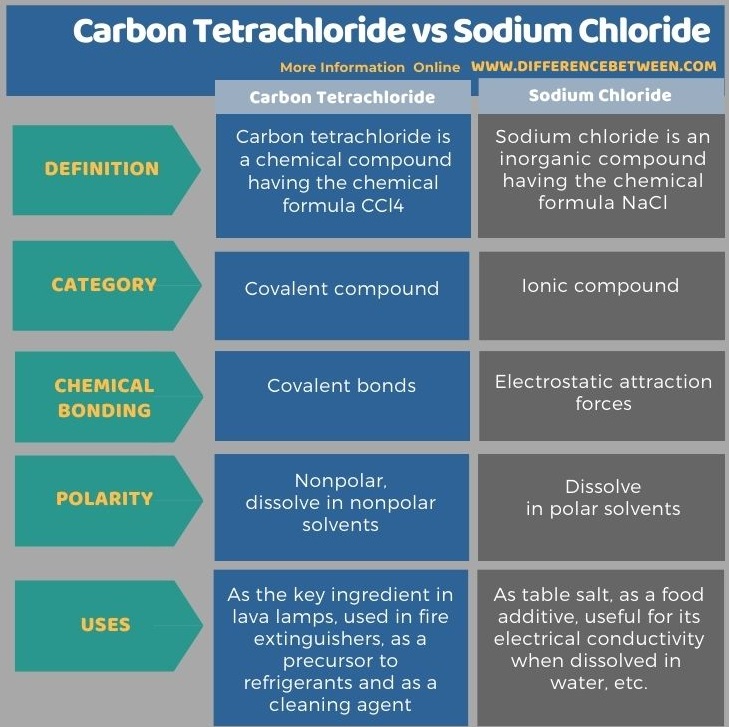Difference Between Carbon Tetrachloride and Sodium Chloride
The key difference between carbon tetrachloride and sodium chloride is that carbon tetrachloride is a covalent chemical compound whereas sodium chloride is an ionic chemical compound.
Both carbon tetrachloride and sodium chloride are chlorine-containing chemical compounds. However, these two chemical compounds differ from each other according to the chemical structure, properties and applications.
CONTENTS
1. Overview and Key Difference
2. What is Carbon Tetrachloride
3. What is Sodium Chloride
4. Side by Side Comparison – Carbon Tetrachloride vs Sodium Chloride in Tabular Form
5. Summary
What is Carbon Tetrachloride?
Carbon tetrachloride is a chemical compound having the chemical formula CCl4. It is commonly called “tetrachloromethane”. Carbon tetrachloride is a colourless liquid having a sweet smell. Therefore, it is easy to detect this compound from its smell even at low levels.

The molar mass of carbon tetrachloride is 153.81 g/mol. It has a melting point of −22.92 °C, and the boiling point is 76.72 °C. When considering the geometry of the carbon tetrachloride molecule, it has the tetrahedral geometry. There are four chlorine atoms bonded to a single carbon atom, and the bond angles of the molecules are equal. Therefore, we call it a “symmetrical geometry”. This geometry makes the compound nonpolar. It resembles the structure of a methane molecule, which has four hydrogen atoms bonded to a single carbon atom.
There are many uses of carbon tetrachloride. Before the prohibition, this compound was used to produce CFC in large scale. Nowadays, we do not produce CFC since it harms the ozone layer. Carbon tetrachloride is the key ingredient in lava lamps. Once it was a popular solvent, but now we don’t use it due to its adverse health effects. Moreover, we widely use it in fire extinguishers, as a precursor to refrigerants and as a cleaning agent.
What is Sodium Chloride?
Sodium chloride is an inorganic compound having the chemical formula NaCl. The molar mass of this compound is 58.44 g/mol. At room temperature and pressure, sodium chloride appears in solid-state, as colourless crystals. Moreover, this substance is odourless. In its pure form, sodium chloride cannot absorb water vapour, which means, it is not hygroscopic.

Sodium chloride is a salt of sodium, so it is an ionic compound. This compound contains one chorine atom per each sodium atom of the molecule. Sodium chloride salt is responsible for the salinity of seawater. The melting point is 801◦C while the boiling point is 1413◦C. In sodium chloride crystals, each sodium cation is surrounded with six chloride ions and vice versa. Therefore, we call the crystal system as a face-centred cubic system.
Sodium chloride dissolves in high polar compounds such as water. Here, water molecules surround each cation and anion. Each ion often has six water molecules around them. However, the pH of an aqueous sodium chloride lies around pH7 due to the weak basicity of chloride ion. We say there is no effect of sodium chloride on the pH of a solution.
What is the Difference Between Carbon Tetrachloride and Sodium Chloride?
Both carbon tetrachloride and sodium chloride are chlorine-containing chemical compounds. The key difference between carbon tetrachloride and sodium chloride is that carbon tetrachloride is a covalent chemical compound whereas sodium chloride is an ionic chemical compound. Moreover, carbon tetrachloride dissolves in nonpolar solvents while sodium chloride dissolves in polar solvents.
Below infograhic summarizes the differences between carbon tetrachloride and sodium chloride in tabular form.

Summary – Carbon Tetrachloride vs Sodium Chloride
Carbon tetrachloride and sodium chloride are different from each other according to the chemical structure, properties and their applications. The key difference between carbon tetrachloride and sodium chloride is that carbon tetrachloride is a covalent chemical compound whereas sodium chloride is an ionic chemical compound.
Reference:
1. Haskins, J. (2018, September 29). What Is Sodium Chloride and How Is It Used? Retrieved October 14, 2020, Available here.
Image Courtesy:
1. “Carbon Tetrachloride” By H Padleckas, vectorized by MaxDZ8 – H Padleckas, vectorized by MaxDZ8, Public Domain) via Commons Wikimedia
2. “Sodium chloride crystals” By Stanislav.nevyhosteny – Own work (CC BY-SA 4.0) via Commons Wikimedia
ncG1vNJzZmivp6x7pbXFn5yrnZ6YsqOx07CcnqZemLyue8OinZ%2Bdopq7pLGMm5ytr5Wau26vwKuZqKZdqbK1vsCcn6Wnop6xpnnAp5tmq5%2BZtra5jJyfpaeinrGmew%3D%3D